[ad_1]
Virologist Dave O’Connor admits that he was getting desperate when he started asking dog owners for poo samples.
For much of 2022, O’Connor, at the University of Wisconsin–Madison, and his colleagues have been tracking a heavily mutated variant of SARS-CoV-2, the virus that causes COVID-19. Early this year, they discovered the variant in Wisconsin waste water drawn from more than 100,000 people.
Following the sewer system to ever-smaller watersheds, they narrowed the variant’s source to one particular area. O’Connor and his team thought that the variant might be circulating in dogs, in part because they found canine genetic material in the same wastewater samples. So they headed to the local dog park. “It was the strangest request you’re ever going to hear: ‘Hey, we’re scientists. Can we just have that bag of dog poop that you’re throwing away?’”
The dogs turned out to be another red herring in the team’s months-long quest to trace the variant’s origin.
Similar-looking variants have turned up in people with compromised immune systems — and, increasingly, researchers think that variants from chronic infections in these people might give rise to pandemic-altering lineages, such as Omicron.
O’Connor and his team think that they’re searching for a person carrying the variant — there’s no evidence that the lineage has spread to anyone else. The researchers are working with public-health officials, who hope that by identifying the person — who has been infected for at least eight months — they can treat the infection and reduce the chances of it ever spreading.
No individual case stands much chance of brewing the next super-variant (likely to be dubbed Pi under the WHO’s variant-naming system). But tracing the source of one potential variant — among the thousands probably circulating globally — might help researchers to understand the biological factors that caused variants such as Omicron to emerge. Such infections could also act as a crystal ball into the virus’s future.
“This is where Pi is going to come from. I don’t think people realize how much it’s already here. A lot of the lineages we are finding make Omicron look pedestrian,” says Marc Johnson, a virologist at the University of Missouri in Columbia who, with O’Connor, is co-leading efforts to trace wastewater lineages in Wisconsin, and spearheading searches for similar variants in two dozen other places.
“It’s such smart detective work. It’s phenomenal,” adds Bill Hanage, an epidemiologist at Harvard T.H. Chan School of Public Health in Boston, Massachusetts. “We still don’t really know where variants come from.”
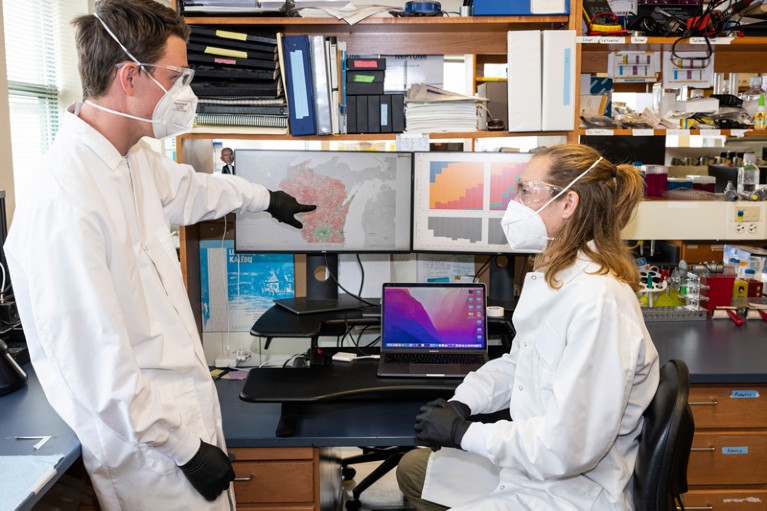
Lab members Max Bobholz (left) and William Vuyk with a computer animation that shows the evolution of COVID-19 across Wisconsin.Credit: Jeff Miller/UW-Madison
Cryptic lineages
Public-health investigators have been plumbing water for more than a century: in 1854, British epidemiologist John Snow traced a London cholera outbreak to a contaminated water pump. The global push to eradicate poliovirus, which is shed in faeces, relies on detecting viruses in waste water, because paralysis cases are so rare.
During the pandemic, researchers found that sewer-sampling can offer warning of COVID-19 surges. Most of these efforts focused on common SARS-CoV-2 variants circulating in the community that were picked up in routine testing. But in March last year, Johnson and his colleagues started noticing viral lineages in waste water that didn’t match anything in global databases containing millions of sequences.
These ‘cryptic lineages’ were laden with changes to the spike protein that SARS-CoV-2 uses to enter cells — and which the immune system targets. These changes would later turn up in immune-evading variants such as Omicron.
Wastewater sequencing for SARS-CoV-2 can be exquisitely sensitive. But when Omicron cases flooded the watersheds that Johnson was studying in late 2021, they drowned out the cryptic lineages that his team was hunting. To overcome this, Johnson developed a sequencing approach to identify rare, non-Omicron lineages that might have been infecting just a single person. “You’re really looking for a needle in the haystack,” he says.
With this method in place, Johnson put a call out for waste water, ultimately collecting samples from more than 600 areas served by wastewater collection systems, in 39 US states. “I wrote to everyone I knew. I posted it on Twitter: ‘I’m just like, send me your shit.’”
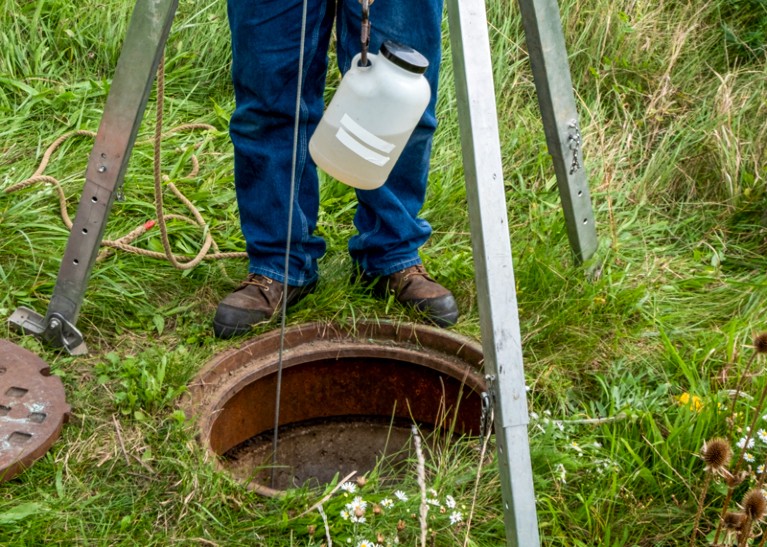
The research required municipal workers to place dozens of sewage-sampling devices under manhole covers. Credit: Jan Klawitter/WI State Lab of Hygiene, UW-Madison
Martin Shafer, an environmental biogeochemist at Wisconsin State Laboratory of Hygiene in Madison, provided samples from the state. O’Connor, whose lab was part of a Wisconsin-wide effort to track SARS-CoV-2 through wastewater and air sampling, mobilized a team to investigate the cryptic lineage that the researchers are now tracking. The variant, which first appeared in sewage collected in January 2022, shared numerous mutations with Omicron, but came from an entirely different part of the SARS-CoV-2 family tree.
“We didn’t stumble across this. I was hunting,” Johnson says. “I wanted to know what the source was.”
Sewer sleuths
To narrow down the variant’s origin, the researchers followed samples that had been collected from smaller and smaller watersheds in the sewer network (see ‘Hunting a cryptic lineage’). This required municipal workers to place dozens of specialized sampling devices beneath manhole covers during the depths of the Wisconsin winter. “People were doing work well outside their job descriptions,” says O’Connor.
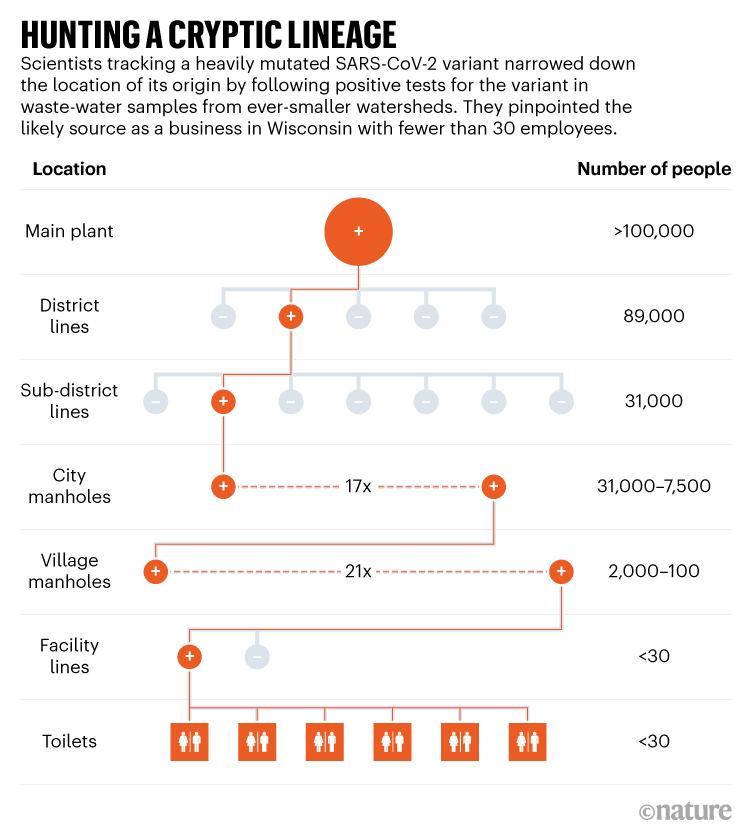
Source: Dave O’Connor and Marc Johnson https://openresearch.labkey.com/_webdav/Coven/human-source-cryptic-SARS-CoV-2-lineages/%40files/SPHERES-wastewater/index.html
Such help can’t be taken for granted, says Rose Kantor, a microbiologist at the University of California, Berkeley, who is working with Johnson to trace cryptic lineages in California waste water. Their investigations hit a dead end when they couldn’t convince officials to collect additional samples.
As the search for the Wisconsin variant narrowed, Johnson was perpetually worried that the variant would disappear. “This wasn’t the first time we tried to track a lineage, but often they fizzle out,” he says. “I was constantly flipping out.”
But at each fork in the sewer system, the lineage was found along only one path. After ruling out dogs, rats and deer — which can all carry SARS-CoV-2 — the researchers suspected that they were looking for a person with a chronic infection. In June, they traced the lineage to waste water from a single business with fewer than 30 employees (the researchers wish to keep the name and location of the business confidential to protect the community’s privacy). The researchers are preparing a preprint describing the investigation.
Evasion skills
While public-health officials involved in the investigation weighed their next moves, O’Connor and Johnson’s team continued tracking the variant and studying its properties.
Since its discovery, the lineage had gained extra mutations and its genetic diversity had grown — hallmarks of a virus evolving in a single person’s body without spreading. Experiments showed that the variant was even better than the Omicron lineage BA.1 at thwarting antibodies triggered by vaccination and previous infection.
But it wasn’t clear what risk the variant posed to anyone other than the person carrying it. “The vast majority of these lineages are not transmitting to the best of our knowledge,” says O’Connor.
Ryan Westergaard, the state epidemiologist for communicable diseases at the Wisconsin Department for Health and Safety in Madison, says that his team thought long and hard before asking the company and its employees whether they would be tested for SARS-CoV-2. “We didn’t want to cause panic and say there’s a dangerous new variant lurking in our community,” he says. But he wanted to help the person carrying the infection to get treatment — and reduce any risk of spread.
About 60% of the company’s employees have come forwards for nasal swab testing but none seems to carry the cryptic lineage. Westergaard’s team is now looking out for the variant in community SARS-CoV-2 testing, and in waste water from other Wisconsin sewers. The researchers are also going back to previously collected clinical specimens to see whether the variant has turned up already. “We’re remaining vigilant,” says Westergaard.
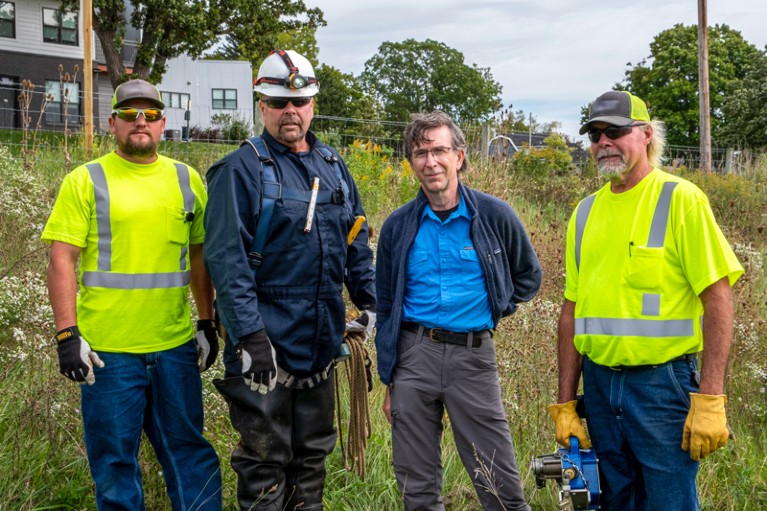
Environmental biogeochemist Martin Shafer (second from right) with the Wisconsin municipal engineers who collected wastewater samples to track the cryptic lineage.Credit: Jan Klawitter/WI State Lab of Hygiene, UW-Madison
Gut instinct
Johnson, O’Connor and their team haven’t given up their search. They continue to detect the variant, and at quantities that Johnson has never seen before in waste water. At those levels — and combined with the employees’ negative nasal swabs — Johnson wonders whether the infected person is harbouring the virus mainly in their gut, rather than their airways. The team hopes to analyse stool samples from willing employees and is seeking ethical approval for such a study.
Smruthi Karthikeyan, a computational biologist at the University of California, San Diego, noticed something similar while conducting wastewater sequencing at university buildings. Some people shed large quantities of SARS-CoV-2 genetic material for weeks after their airway infections and symptoms disappeared.
Chronic gut infections are a strong candidate for the source of SARS-CoV-2 variants of concern such as Omicron, says Kristian Andersen, an evolutionary biologist at Scripps Research in La Jolla, California. Immune cells in the gut are more tolerant of microorganisms than are those elsewhere in the body, potentially allowing the virus to evolve in the presence of some — but not too much — immune pressure. In most cases, such gut infections will never transmit to others, Andersen says — unless something in the body changes and the virus moves back to the airways. “Then that gives the risk of an emergence event like Omicron,” he hypothesizes.
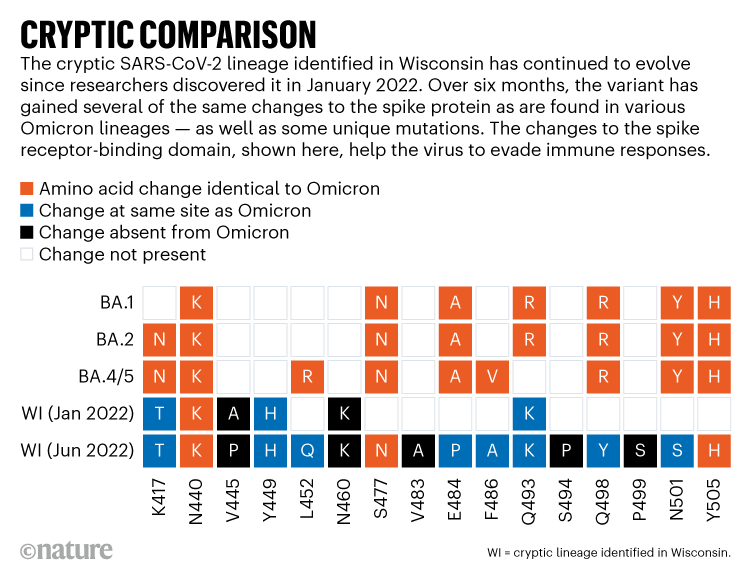
Source: Dave O’Connor and Marc Johnson https://openresearch.labkey.com/_webdav/Coven/human-source-cryptic-SARS-CoV-2-lineages/%40files/SPHERES-wastewater/index.html
Identifying the person in Wisconsin might therefore help researchers to understand how variants such as Omicron emerge, Andersen adds. “What this shows you is the engine of variants,” he says. “The detective work they’ve done is unbelievable.”
Even if the researchers cannot identify a person carrying the Wisconsin lineage, studying cryptic lineages like it might help to predict SARS-CoV-2’s future, says O’Connor. Most of its standout mutations are in the spike protein, but his team has identified changes to key regions of another viral molecule, called membrane protein ectodomain, that might also be important to immunity (see ‘Cryptic comparison’).
Cryptic lineages might not turn out to be the “oracle of the toilet bowl”, says O’Connor, but if they can help to forecast broad trends in SARS-CoV-2 evolution, this could help researchers to test vaccines and treatments against potential future variants — which might already be bobbing around a sewer somewhere in the world. “If we see this in Wisconsin by shining a bright light on it,” says O’Connor, “you have to know that it’s happening everywhere.”
[ad_2]
Source link

